
12 minute read
Attachments & Parts Section
Pages 33-39S E C T I O NAttachments
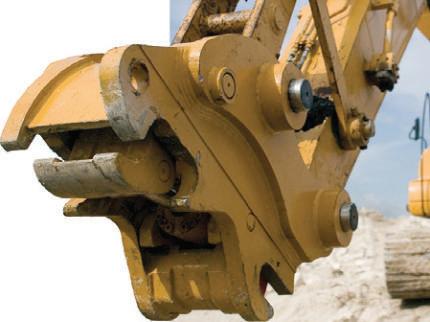
For more information about these attachments and more, visit our Attachments Section on our Web site at www.constructionequipmentguide.com
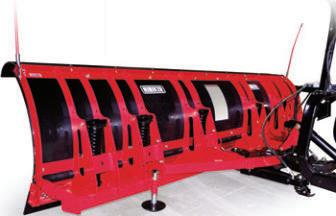
Proper Tools Help Ohio Contractor Prevent Ditch Bank Erosion
Werk-Brau buckets and attachments are used all over the world, but when the project is in your own hometown … well that hits a little differently. So, when the Weber Company of Archbold, Ohio, recently embarked on a project to control erosion along a drainage ditch that ran through nearby Findlay, Ohio, Werk-Brau employees were proud to see their handiwork used to improve their local community.
The Dalzell ditch is roughly 3 mi. long and winds its way through several areas of town, including residential neighborhoods, industrial zones, commercial areas including restaurants and hotels, adjacent to Findlay High School and along Interstate 75. Weber was tasked by Hancock County with placing rip rap in roughly 2 mi. of the ditch — areas that were most susceptible to erosion as marked by county engineers. Weber crews would restructure the steeply sloped ditch banks, those with slopes approaching 2:1, to better accommodate the incoming rip rap, grooming both sides if necessary to hold the sides in place and prevent further erosion and damage.
Because of the winding nature of the drainage ditch and the extremely wet weather, which both precluded bringing heavy equipment onto the jobsites and caused further erosion that they were trying to eliminate, the project presented some peculiar challenges.
Armed with unique tools including a Case CX 250 long stick excavator with a Werk-Brau 2-yd. ditching bucket and a side dump trailer, Isaac Weber and his team made respectable progress and completed the project within their established timeframe.
Weber and his team began the project in early November. Starting in the residential areas posed some challenges as well as some opportunities. Since there was no place to stockpile material, they were running it in as needed, day by day, which was a challenge as the Carey Quarry was about an hourand-a-half round trip from the job site.
“We have a side dump trailer so we can pull right up to the guardrail and dump a full load over the side,” said Nate Meyer, project coordinator. “One load will do one side and a little of the bottom, and the next load will do the other side and a little bit of the bottom.”
While awaiting the next trailer load of rip rap, excavator operators would distribute the rock as needed, shoring up or restructuring the ditch sides as required.
The side dump trailer allowed Weber crews to accomplish 40-ft. of the project at a time, helping them to average roughly 400 to 500 ft. per day depending on how fast they could get rock from the quarry.
After the ditch wound its way out of the residential areas where the side dump trailers were no longer feasible, Weber crews stockpiled material and moved it with a John Deere 624P wheel loader equipped with a 3.5-yd. bucket. The loader would dump a load of rip rap into the ditch, favoring whichever side was being shored up at present. They would then go back for another load while the excavator distributed the rip rap along the ditch banks. A trio of excavators were used on the project — a Case CX130, a Case CX210 and a Case CX250 — all fitted with Werk-Brau quick couplers and buckets.
“We trust Werk-Brau products. When I see that logo, I know I’m getting a high-quality, durable product that will do what it was designed to do,” said Weber.
Stockpiling materials kept the excavator and loader operators busy, but tight confines and space constraints required creativity in certain areas.
“We had a spot where the ditch ran in between the back yards of houses, so there was nowhere for an excavator to go,” said Meyer. “So, we built a ramp out of rip rap and drove the loader down there and dumped a bunch of stone. Then we brought in the Case CX130C excavator and placed it on the sides.” While not ideal, the scenario worked … for the most part. “He did have a rock get caught in the track, and then it walked the track off in the ditch,”said Meyer. “That was a pain. We put a load of rock in his bucket, extended his arm way out so that he was just traveling on one track, and he onetracked it out of there.” Meyer had another Case CX 210 excavator pulling the CX130C to keep the limping excavator moving straight. He laughs about it now but said that it was “a nightmare” at the time. The smaller CX130C and CX210 excavators were viable choices in many sections, but Meyer remembers one area where the long reach of the Case CX 250 long reach was essential.
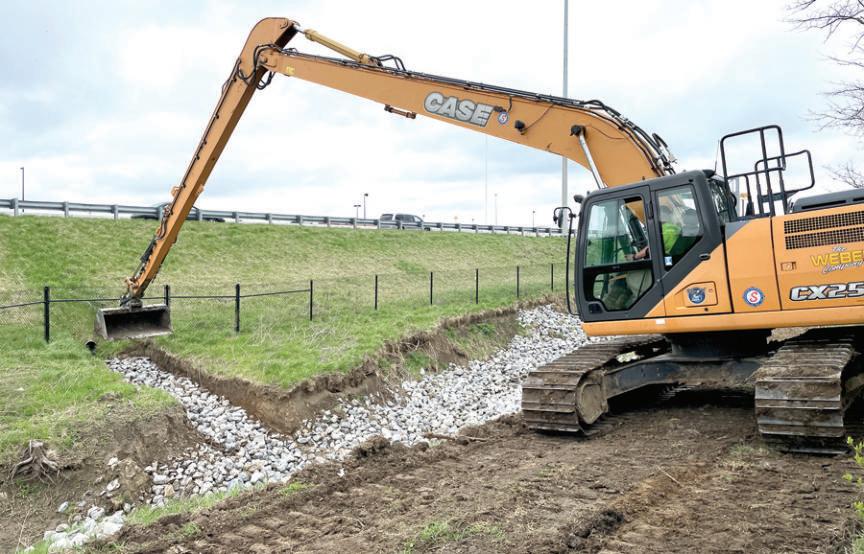
A trio of excavators were used on the project — a Case CX130, a Case CX210 and a Case CX250 — all fitted with Werk-Brau quick couplers and buckets.
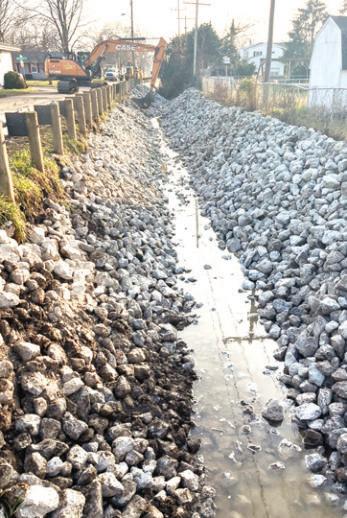

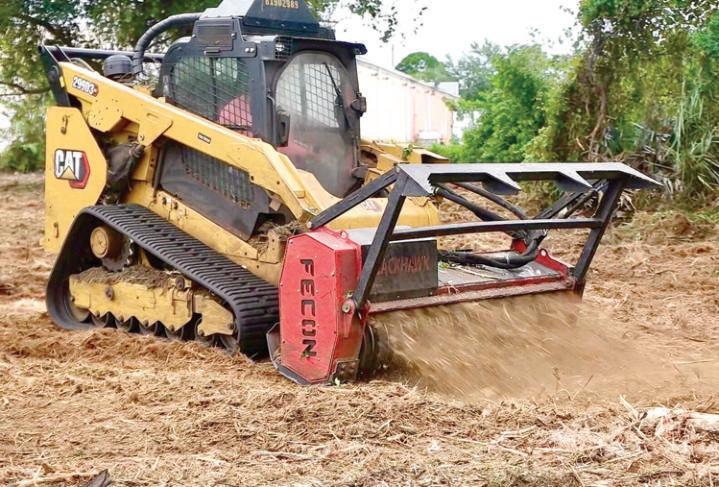
Fecon’s Bull Hog mulcher has the ability to mulch up to 6 in. material with ease due to its bite-limiting rotor design and a variable speed motor, which automatically adjusts to maximize rotor-speed and torque to changing material loads.
The housing community of Connection, Fla., planned to connect the community's pond to the community through boardwalks. Unfortunately, after cutting the path and putting the sidewalk in, the rest of the project was put on hold.
You may have heard about a bridge to nowhere, but what about a sidewalk to nowhere?
This was the predicament one community north of Tampa, Fla., was facing. After making a 1,500-ft. sidewalk on the back side of a pond, the community couldn’t build the accompanying bridges to connect the sidewalk to the rest of the complex.
Battling Brazilian Peppertree
The housing community of Connerton, Fla., north of Tampa had grand plans for putting in a sidewalk around the back side of the community’s pond and then connecting it to the community through boardwalks at each end. Unfortunately, after cutting the path and putting the sidewalk in, the rest of the project was put on hold. Over the next 10 years, the sidewalk was overtaken on both sides by the Brazilian Peppertree, vines, crepe myrtles, and other undergrowth.
When the project got enough interest to start the second phase of work, Clear Cut Forestry Mulching owner Tim Hileman got the call.
“We had a drone out looking for the sidewalk and you couldn’t see it,” Hileman said, explaining the degree of overgrowth present. Collectively working off blueprints and with the engineers, the team believed they knew where the sidewalk was hiding. Now they just needed to find a way to get to it.
The shortest distance between two points is a straight line. So Hileman started at one of the community’s access points and cut himself a half mile long trail through the woods to the suspected sidewalk location.
“We never would’ve been able to get in there any other way…Then we saw the beginning of the slab and started following it.”
Around 1,500-ft. later Hileman found the other end.
After freeing the sidewalk, Hileman cleared 10 ft. of room on either side. This allowed the engineers to finally access the sidewalk to assess it before working on the connecting bridges. Two and a half days of work gave a community their sidewalk back.
The Brazilian Peppertree is so invasive and common in Florida that Hileman encounters it at nearly every job site. Thankfully for Clear Cut and its clients, this undergrowth is easily tamed by Hileman’s Fecon Bull Hog mulcher.
How It Works
Fecon’s Bull Hog mulcher is an extremely durable mulcher with the ability to mulch up to 6 in. material with ease due to its bite-limiting rotor design and a variable speed motor which automatically adjusts to maximize rotor-speed and torque to changing material loads.
Thirty double-sided, Samurai knife edge cutting tools are mounted onto the FGT style rotor, creating a 61 in. cutting width. The attachment requires 30 to 45 gpm flow at up to 6,000 psi, which is delivered by a Caterpillar high flow skid steer.
The FGT rotor system features a smooth rotor surface, spiral tool pattern and innovative tool shape for efficient cutting. Hileman sharpens his blades twice a week and flips them after every 15 running days.
When it comes to mulcher attachment maintenance, Hileman greases the head every morning with four pumps and then another four pumps at lunch on the bearings.
Hileman had such a good experience building his business with his Fecon mulching attachment that he decided to stick with the brand when it came time to grow his equipment arsenal. Pairing another used Fecon Bull Hog mulcher with a brand-new 299D2 XHP Caterpillar, Clear Cut continues to serve the Tampa area with its reliable and durable equipment built to deliver in the toughest working conditions.
Durable Mulcher
Launches Two Businesses
Some say word of mouth is the most effective marketing. When someone is so moved by their experience with a brand that they must tell someone else about it, it can be a very persuasive sales tactic. A personal rec-
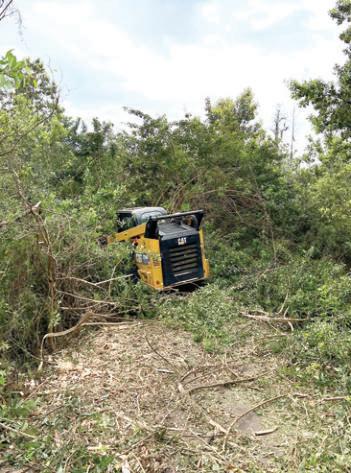
Over 10 years, the sidewalk was overtaken on both sides by the Brazilian Peppertree, vines, crepe myrtles and other undergrowth. Clear Cut Forestry Mulching owner Tim Hileman started at one of the community’s access points and cut himself a halfmile long trail through the woods to the suspected sidewalk location.
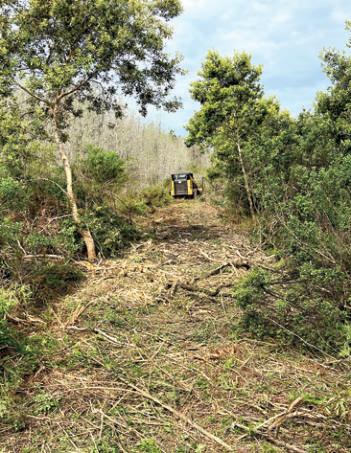


Weber Choooses Werk-Brau
WEBER from page 33
“There was a pipe that went underneath the fence on the far side of a wide section of the ditch. We were able to reach the pipe, dig it out and put the new pipe in with the long reach excavator,” said Meyer, recalling how they used pretty much all of the more than 60 ft. reach of the Case CX 250.
In addition to tight quarters, the wet terrain required some creativity from the machine operators as well. In the final section of ditch, alongside I-75, the access point was off a side street, with a dirt path entryway roughly 1,000 ft. long. Near the roadway the footing was fine, but as it neared low lying area closer to the highway the ground became downright swampy. They stockpiled material — both rip rap and 57’s — but the loader had to travel another 1,000 to 1,500 ft. to the ditch area being worked on. But first the operators had to reconstruct the pathway, removing mud to get to drier material, and placing rock where needed to shore up the footing to allow the loader and the excavator to safely and efficiently traverse the area.
Despite unpredictably bad weather patterns, the region received near record precipitation over the project period, having the right tools at hand allowed the Weber Company to keep this project on track and moving forward. After completion, the next heavy rain would have water passing through the ditch but not carry any of the ditch bank with it. Knowing that they played a small part in this Hancock County erosion control effort, Werk-Brau employees stand proud of their company, their products and the impact that they have not only on the local community but in other communities across the country.
For more information, visit WerkBrau.com.
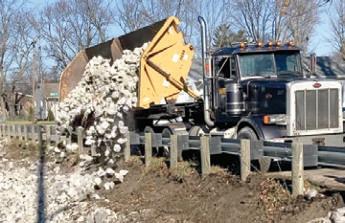
The side dump trailer allowed Weber crews to accomplish 40-ft. of the project at a time, helping them to average roughly 400 to 500 ft. per day, depending on how fast they could get rock from the quarry.
Overgrown Sidewalk Is No Match for Fecon Bull Hog
FECON from page 36 ommendation was powerful enough to convince Hileman to drop what he was doing and follow a friend into the mulching business. Hileman even purchased his first mulcher head attachment straight from him.
Mike Cram with Heavy Brush Mowing started his business in Brevard County, Fla., with a Fecon Bull Hog mulcher. Fast forward seven years and Hileman realized he could do the same…with the same exact mulcher.
“I always saw Mike’s videos but never paid too much attention to them. Then one day I had a meeting at one of his job sites and I saw the mulcher and was just blown away.”
Hileman was impressed, and had such a good friend in Cram, that he was able to borrow Cram’s whole rig and trailer to do his first ever job in Brevard County. Cram then taught Hileman how to use the equipment to not only clear the land but also to make it look presentable after the fact. He provided Hileman with industry expertise in addition to equipment.
Hileman was so moved after getting to use the equipment that he decided to purchase the seven-year-old mulcher from his friend.
“As the bearings are good, the head’s balanced, and the pumps are good, regardless of what the attachment looks like, it’ll still run just as good as new.”
After adding a Caterpillar high flow skid steer to his arsenal, Clear Cut was born. Two years into operating and the business has added a Caterpillar 299D3 XE high flow skid steer and another used Fecon Bull Hog mulching attachment to its arsenal.
Both mulchers and Cat high flow skid steers are still working, clearing brush and undergrowth in the south Florida area. Hileman figures his business is split 50/50 between residential lot clearing/property improvement and commercial thinning.
While the act of mulching is an act of removal, Hileman’s work is sometimes addition by subtraction, like when he gave a community their sidewalk (and future plans) back by removing the brush.
For more information, visit www.fecon.com.


